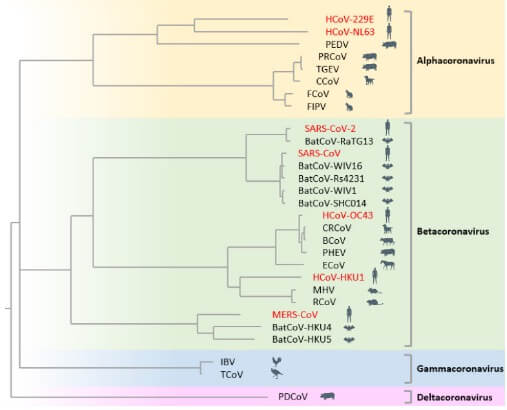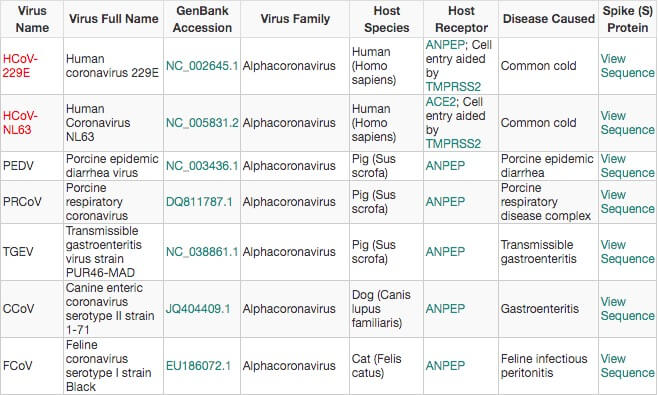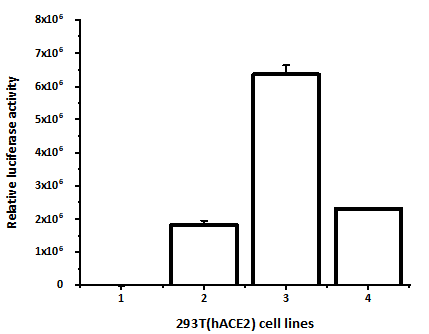Cell Line Models for Coronavirus Research
Cell line 모델은 바이러스의 분리, 증식 및 유전공학 등 coronavirus 연구에 필수적인 역할을 해 왔으며, 세포 진입 메커니즘과 세포가 감염에 반응하는 방식 연구에도 사용되고 있다. 다양한 coronavirus 종은 분리, 증식 및 메커니즘 연구를 위해 다른 유형의 세포가 필요할 수 있으며, 이는 coronavirus의 다양성을 고려할 때 어려울 수 있다.
Coronavirus는 자연에 널리 퍼져 있는 방대한 바이러스 그룹을 구성하며, 사실상 검사된 거의 모든 포유류와 조류를 감염시킨다. 지금까지 수백 종의 coronavirus가 알려졌다. 이들 중 수십 종은 인간, 가축, 애완 동물 또는 동물모델을 감염시키거나 또는 이들과 진화적으로 밀접한 관련이 있기 때문에 중요하다고 볼 수 있다. 이 중요한 coronavirus 종의 phylogenetic tree는 다음과 같다.
Phylogenetic Tree of Important Coronavirus Species

중요한 coronavirus 종에 대한 자세한 정보는 아래 표에 열거되어 있다.
List of important coronavirus species

VectorBuilder는 위의 coronavirus 종을 연구하기 위해 아래에 설명된 다양한 cell line 모델을 제공한다.
Types of cell lines offered
Coronavirus 연구에 사용되는 cell line은 크게 세가지 카테고리로 분류할 수 있다.
(1) 바이러스 분리 및 증식을 위한 virus growth cell line.
(2) 재조합 벡터를 살아있는 바이러스로 패키징하기 위한 virus packaging cell line.
(3) 호스트 세포로의 바이러스 진입 메커니즘 및 바이러스의 다른 측면을 연구하기 위한 virus assay cell line.
Click here to view experimental validation of our virus assay cell lines
아래에 기재된 대로 VectorBuilder는 이러한 모든 요구를 충족하는 다양한 cell line 패널을 제공한다.
Coronavirus growth cell lines
이들 세포는 관심있는 coronavirus 종에 자연적으로 감염되기 쉽고, 바이러스를 분리하고 증식하는 데 사용할 수 있다. 객담이나 감염된 조직과 같은 감염된 생물학적 샘플에서 살아있는 바이러스의 초기 분리를 위해 세포에 샘플을 접종하고 배양한다. 성공적인 감염은 많은 경우에 cytopathic effect (CPE)로 이어질 수 있지만 반드시 모든 경우에 그런 것은 아니다. 세포에서 생성된 바이러스는 전자 현미경 및 시퀀싱으로 검증된다. 특정 유형의 바이러스를 분리하는데 사용되는 세포는 일반적으로 바이러스를 무한히 증식하고 대량으로 증폭하는데 사용된다. 이들 세포는 또한 세포 진입을 포함한 바이러스 연구에 사용될 수 있다.
CoronaGrow™ cell line 패널은 대부분의 coronavirus 종의 분리 및 증식을 용이하게 하도록 디자인되었다.
| Cell Line Name | Description | Coronavirus Tested* |
|---|---|---|
| CoronaGrow-VeroE6 | Subclonal line of Vero-E6 cells derived from adult African green monkey (Chlorocebus aethiops) kidney. It is susceptible to infection by many coronavirus species including SARS-CoV-2, and is the cell line of choice for the isolation and propagation of many viruses. | SARS-CoV-2, SARS-CoV, MERS-CoV, PanCoV-GD/P2S, BatCoV-WIV16, BatCoV-Rs4231, BatCoV-WIV1, BatCoV-RsSHC014, PEDV |
| CoronaGrow-Huh7 | Subclonal line of Huh7 cells derived from human liver cancer. It is susceptible to infection by many coronavirus species including HCoV-229E. | HCoV-229E, SARS-CoV-2, SARS-CoV, MERS-CoV |
| CoronaGrow-Frhk4 | Subclonal line of FRhK-4 cells derived from rhesus macaque (Macaca mulatta) fetal kidney. It is susceptible to infection by some coronavirus species including SARS-CoV. | SARS-CoV, CivetCoV-SZ3 |
| CoronaGrow-MK2 | Subclonal line of LLC-MK2 cells derived from rhesus macaque (Macaca mulatta) adult kidney. It is susceptible to infection by some coronavirus species including HCoV-NL63. | HCoV-NL63, SARS-CoV |
| CoronaGrow-L2 | Subclonal line of L2 cells derived from rat lung. It is susceptible to infection by some coronavirus species including MHV. | MHV, RCoV |
| CoronaGrow-HRT18G | Subclonal line of HRT-18G cells derived from human colon cancer. It is susceptible to infection by some coronavirus species including HCoV-OC43. | HCoV-OC43, BCoV, ECoV, CRCoV, RbCoV |
| CoronaGrow-Neuro2a | Subclonal line of Neruo-2a cells derived from mouse neuroblastoma. It is susceptible to infection by some coronavirus species including PHEV. | PHEV |
| CoronaGrow-ST | Subclonal line of ST cells derived from pig testis. It is susceptible to infection by some coronavirus species including TGEV. | TGEV, PRCoV, PDCoV |
| CoronaGrow-Fcwf4 | Subclonal line of Fcwf-4 cells derived from cat fetal macrophages. It is susceptible to infection by some coronavirus species including FIPV. | FIPV, FCoV |
| CoronaGrow-A72 | Subclonal line of A-72 cells derived from dog fibroblasts. It is susceptible to infection by some coronavirus species including CCoV. | CCoV |
* 각 cell line에 기재된 바이러스의 경우 세포가 바이러스의 분리 및 증식을 지원하는 것으로 나타났다. 그러나, 세포가 목록에 없는 다른 coronavirus 종의 성장을 지원할 가능성을 배제하지는 않는다.
참고: 빨간 글씨의 coronavirus 종의 경우, 기재된 cell line이 분리 및 증식을 위해 권장된다.
Coronavirus packaging cell lines
이들 세포는 관심있는 바이러스 게놈의 야생형 또는 변이형을 운반하도록 조작된 재조합 벡터로부터 살아있는 바이러스를 패키징하는데 사용된다.
바이러스 패키징을 수행하기 위해 벡터 DNA 또는 in vitro transcribed RNA를 packaging cells로 transfection 시킨다. 일단 세포에 들어가면 DNA 또는 RNA가 세포 기구를 이용하여 살아있는 바이러스를 생성한다. Packaging cell line은 높은 transfection 및 패키징 효율 때문에 선택되지만, 바이러스 결합 및 세포 진입을 위한 적절한 receptor를 발현하지 않을 수 있기 때문에 바이러스의 지속적인 증식을 지원하지 않을 수 있다. 따라서 CoronaPack™ 세포로 패키징된 바이러스는 적절한 CoronaGrow™ cell line을 사용하여 증식해야 한다. 이를 위해 transfection 후 6 ~ 24시간 동안 packaging cell 또는 초기 패키징된 바이러스를 포함하는 상청액을 적절한 CoronaGrow™ 세포에 둘 수 있으며, 이는 차례로 바이러스의 지속적인 증식을 지원한다. 성공적인 바이러스 패키징 및 증식은 많은 경우에 CoronaGrow™ 세포에서 CPE가 발생할 수 있지만 반드시 모든 경우는 아니다.
CoronaPack™ cell line은 기본적으로 모든 coronavirus 종의 패키징을 용이하게 하도록 디자인되었다.
| Cell Line Name | Description |
|---|---|
| CoronaPack-BHK | Subclonal line of BHK-21 cells derived from baby hamster kidney. It is widely used for packaging coronavirus from recombinant vectors. |
| CoronaPack-293T | Subclonal line of 293T cells derived from human embryonic kidney. It can be used as an alternative cell line for packaging coronavirus from recombinant vectors. |
Coronavirus assay cell lines
Coronavirus 연구에서 세포 기반 분석의 주요 적용은 호스트 세포로의 바이러스 진입 메커니즘을 연구하는 것이다. 이는 바이러스 S protein에 의해 인식되는 세포 표면 receptor를 자연적으로 발현하는 cell line을 사용하여 할 수 있다(예: 위에서 설명한 CoronaGrow™ 세포). 또는 receptor를 자연적으로 발현하지 않지만 외인성 도입된 transgene으로부터 receptor를 안정적으로 발현하도록 조작된 cell line을 사용하는 것이다. 이 방법은 세포가 목적 receptor를 높은 수준으로 발현하도록 보장하는 장점이 있다. 중요한 것은, 이 방법으로 변이 receptor의 발현이 바이러스 진입을 용이하게 하는 특정 receptor domain 및 아미노산 잔기의 기능을 밝히는데 도움이 된다.
이러한 receptor 발현 cell line은 자연적으로 분리된 coronavirus 또는 재조합 벡터로부터 인공적으로 패키징된 coronavirus에 의한 바이러스 진입을 분석하는데 사용할 수 있다. 또는 이런 분석은 관심 S protein으로 pseudotype된 재조합 lentivirus를 사용하여 수행할 수 있다. Pseudotyped lentivirus 사용의 주요 장점은 최소한의 biosafety 요구사항이다.
Click here to view our lentivirus pseudotyped with coronavirus S proteins
아래의 CoronaAssay™ cell line 패널은 human ACE2, DPP4 및 ANPEP와 mouse Ceacam1을 포함한 다양한 알려진 coronavirus receptor를 인코딩하는 transgene를 안정적으로 발현하도록 디자인되었다. 또한 human TMPRSS2 transgene을 단독으로 또는 receptor transgene과 함께 발현하는 cell line을 제공한다. TMPRSS2는 ACE2, DPP4, ANPEP 또는 sialic acid를 receptor로 사용하는 많은 coronavirus 종의 세포 진입을 가능하게 하는 것과 관련된 transmembrane serine protease를 인코딩한다. CoronaAssay™ 패널은 Hela (derived from human cervical cancer) 또는 293T (derived from human embryonic kidney) 부모 세포의 subclonal line으로 구성된다.
Click here to view experimental validation
| Cell Line Name | Transgene | Utility | |
|---|---|---|---|
| 293T-Based Cell Lines** | CoronaAssay-293T | None | No-transgene control |
| CoronaAssay-293T(hTMPRSS2) | Human TMPRSS2 | TMPRSS2-alone control | |
| CoronaAssay-293T(hACE2) | Human ACE2 | Assay coronavirus that targets ACE2 receptor (e.g. SARS-CoV-2) | |
| CoronaAssay-293T(hACE2-hTMPRSS2) | Human ACE2 Human TMPRSS2 |
Assay coronavirus that targets ACE2 receptor (e.g. SARS-CoV-2) | |
| CoronaAssay-293T(hACE2-hTMPRSS2-hNRP1) | Human ACE2 Human TMPRSS2 Human NRP1 |
Assay coronavirus that targets ACE2 receptor (e.g. SARS-CoV-2) | |
| CoronaAssay-293T(hANPEP) | Human ANPEP | Assay coronavirus that targets ANPEP receptor (e.g. HCoV-229E) | |
| CoronaAssay-293T(hANPEP-hTMPRSS2) | Human ANPEP Human TMPRSS2 |
Assay coronavirus that targets ANPEP receptor (e.g. HCoV-229E) | |
| Hela-Based Cell Lines* | CoronaAssay-Hela | None | No-transgene control |
| CoronaAssay-Hela(hTMPRSS2) | Human TMPRSS2 | TMPRSS2-alone control | |
| CoronaAssay-Hela(hACE2) | Human ACE2 | Assay coronavirus that targets ACE2 receptor (e.g. SARS-CoV-2) | |
| CoronaAssay-Hela(hACE2-hTMPRSS2) | Human ACE2 Human TMPRSS2 |
Assay coronavirus that targets ACE2 receptor (e.g. SARS-CoV-2) | |
| CoronaAssay-Hela(hACE2-hTMPRSS2-hNRP1) | Human ACE2 Human TMPRSS2 Human NRP1 |
Assay coronavirus that targets ACE2 receptor (e.g. SARS-CoV-2) | |
| CoronaAssay-Hela(hDPP4) | Human DPP4 | Assay coronavirus that targets DPP4 receptor (e.g. MERS-CoV) | |
| CoronaAssay-Hela(hDPP4-hTMPRSS2) | Human DPP4 Human TMPRSS2 |
Assay coronavirus that targets DPP4 receptor (e.g. MERS-CoV) | |
| CoronaAssay-Hela(mCeacam1) | Mouse Ceacam1 | Assay coronavirus that targets Ceacam1 receptor (e.g. MHV) |
* Hela-based cell line은 내인성 ACE2, DPP4, CEAMCAM1 및 TMPRSS2의 발현이 없다.
** 293T-based cell line은 내인성 ANPEP 및 TMPRSS2의 발현이 없다.
Experimental Validation
바이러스 분석 세포주를 최적화하기 위해 당사는 여러 독점 기술을 개발했다. 당사의 바이러스 분석 세포주는 최적화된 pseudotyped lentivirus에 의해 일반적인 transduction 프로토콜에 비해 훨씬 더 높은 효율성으로 transduction 될 수 있다. Transduction된 세포주에 대한 광범위한 실험적 검증을 수행했다. Fluorescent reporter (Figure 1) 및 luciferase reporter (Figure 2)를 사용하여 그 결과, SARS-CoV-2 S 단백질 및 D614G 돌연변이 pseudotyped lentivirus를 갖는 SARS-CoV-2 S 단백질이 높은 수준의 human ACE2 receptor를 발현하는 293T 세포를 효율적으로 transduction할 수 있지만, ACE2 발현이 없거나 낮은 293T 세포는 그렇지 않음을 보여 주었다. 따라서 SARS-CoV-2 S 단백질 또는 VSV-G pseudotyped virus로 transduction에 최적화된 ACE2-expressing cell line을 사용하는 것을 추천한다.
Click here to view our lentivirus pseudotyped with coronavirus S proteins

Figure 1. Lentivirus pseudotyped with SARS-CoV-2 S protein specifically infected 293T cells overexpressing human ACE2 receptor. Images were taken at 72 hours post-transduction.

Figure 2. 293T(hACE2) cells transduced with lentivirus pseudotyped by different proteins. Column 1: Untransduced cells. Column 2: SARS-CoV-2 S protein. Column 3: SARS-CoV-2 D614G S protein. Column 4: VSV-G Protein.
How do I order cell lines?
아래 링크를 따라 당사 cell line에 대해 문의할 수 있다.



